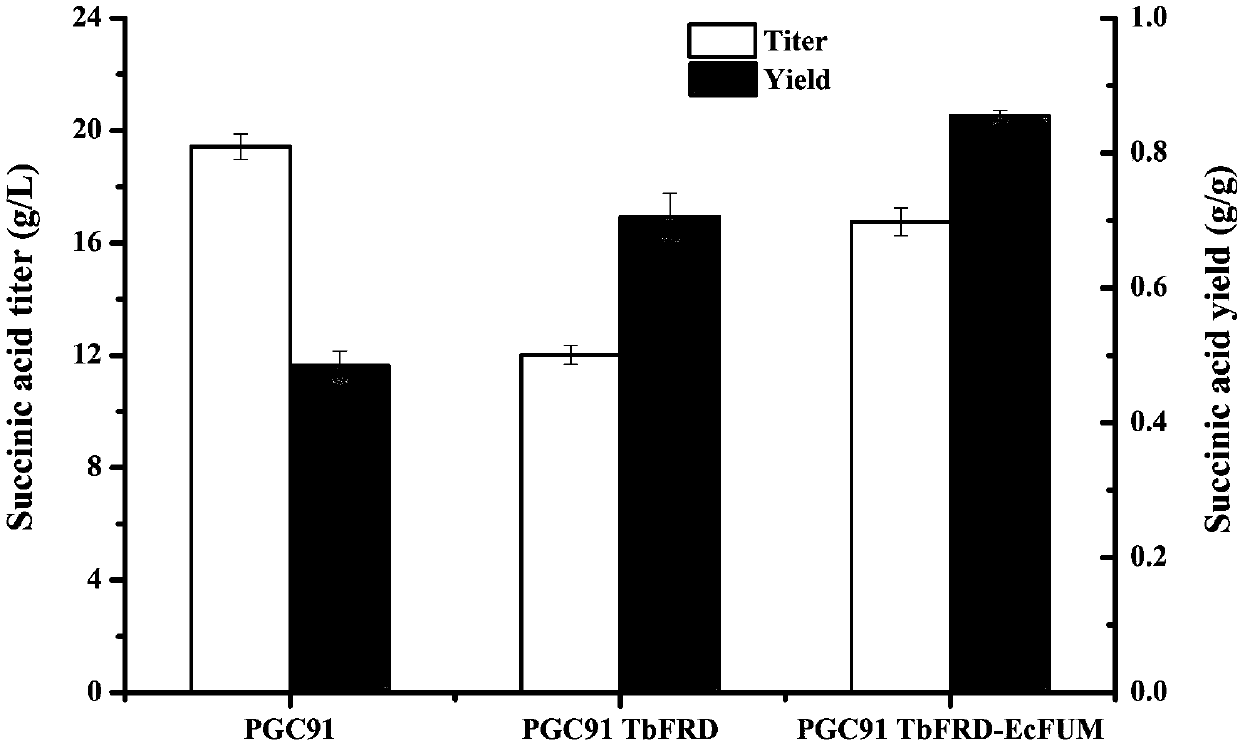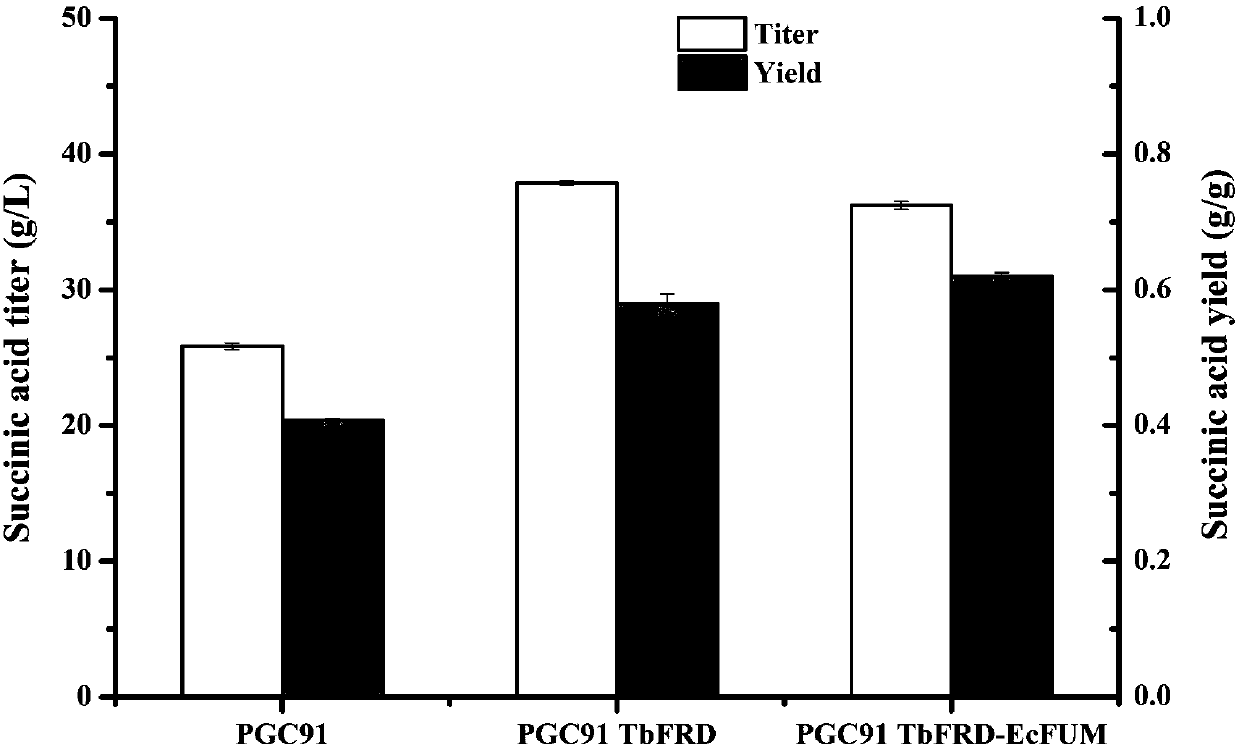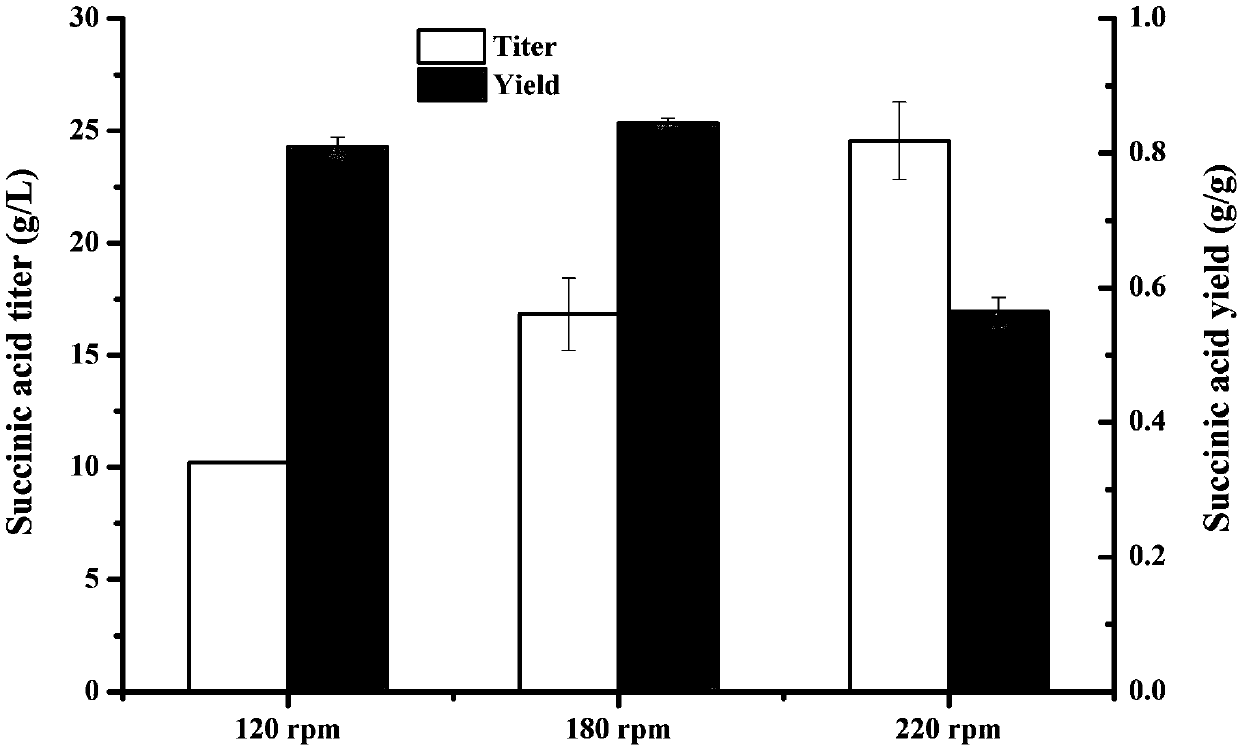Method of utilizing yarrowia lipolytica strain having reductive TCA path to aerobically synthesize succinic acid
A technology of Yarrowia lipolytica and Yarrowia lipolytica, which is applied in the field of metabolic engineering and microbial fermentation, can solve the problems of low theoretical yield, reduce production costs, have good tolerance to acidic conditions, and eliminate by-product ammonium sulfate the effect of
- Summary
- Abstract
- Description
- Claims
- Application Information
AI Technical Summary
Problems solved by technology
Method used
Image
Examples
Embodiment 1
[0042] The construction of embodiment 1 engineering strain
[0043] (1) Overexpression of Tbfrd gene
[0044] Strain: Yarrowia lipolytica PGC91 (Po1f Δsdh5 Δach1 Ylpyc)
[0045] a. Construction of expression vector
[0046] According to the Tbfrd gene sequence (KT026107.1) published by Genbank, it was synthesized by General Biosystems (Anhui) Co., Ltd. after codon optimization. And at the same time design primers according to the expression plasmid pKi-1 sequence:
[0047] Tbfrd-F:
[0048] ATAAGAATCATTCAAAGGTTATGGTGGACGGTCGATCTTC
[0049] Tbfrd-R:
[0050] ACATAACTAATTACATGATTTTAGGAGCCAGAGGGCTCGG
[0051] Using the Tbfrd gene sequence synthesized by codon optimization as a template, PCR (polymerase chain reaction) amplification using Tbfrd-F / Tbfrd-R primers was used to obtain assembled fragments carrying corresponding terminal homologous sequences. PCR reaction conditions: pre-denaturation at 97°C for 5min, denaturation at 94°C for 60s, annealing at 56°C for 30s, exten...
Embodiment 2
[0114] The comparison of different strains of embodiment 2 producing succinic acid efficiency
[0115] Engineering strains: Yarrowia lipolytica (Yarrowia lipolytica) PGC91, PGC91 TbFRD and PGC91TbFRD-EcFUM.
[0116] Yarrowia lipolytica PGC91, PGC91 TbFRD and PGC91 TbFRD-EcFUM stored in frozen glycerol tubes were streaked and inoculated on YPG plates (2% peptone, 1% yeast powder, 2% glycerol, 2% agar powder), and cultured at 30°C for 30h.
[0117] The single colony grown on the above plate was inserted into a 250ml Erlenmeyer flask equipped with 50ml of YPD liquid medium (2% peptone, 1% yeast powder, 2% glucose), and activated by shaking at 220rpm at 30°C.
[0118] Seed culture: 1ml of activated culture solution was transferred to a 250ml Erlenmeyer flask filled with 50ml of fermentation medium (2% peptone, 1% yeast powder, 4% glucose) and cultivated aerobically at 220rpm for 24h at 30°C.
[0119]Fermentation culture: Get 2ml of activated culture fluid and transfer to 250ml Er...
Embodiment 3
[0124] The synthesis of succinic acid of the PGC91 TbFRD-EcFUM strain when glycerol was used as the only carbon source in Example 3
[0125] Engineering strains: Yarrowia lipolytica (Yarrowia lipolytica) PGC91, PGC91 TbFRD and PGC91TbFRD-EcFUM.
[0126] Yarrowia lipolytica PGC91, PGC91 TbFRD and PGC91 TbFRD-EcFUM stored in frozen glycerol tubes were streaked and inoculated on YPG plates (2% peptone, 1% yeast powder, 2% glucose, 2% agar powder), and cultured at 30°C for 30h.
[0127] Insert the single colony grown on the above plate into a 250ml Erlenmeyer flask equipped with 50ml of YPG liquid medium (2% peptone, 1% yeast powder, 2% glucose), and activate it at 30° C. with shaking at 220 rpm. Seed culture: transfer 1ml of activated culture solution to a 250ml Erlenmeyer flask filled with 50ml of fermentation medium (2% peptone, 1% yeast powder, 4% glucose), and cultivate aerobically at 220rpm for 24h at 30°C
[0128] Fermentation culture: get 2ml of activated culture fluid an...
PUM
 Login to View More
Login to View More Abstract
Description
Claims
Application Information
 Login to View More
Login to View More - R&D
- Intellectual Property
- Life Sciences
- Materials
- Tech Scout
- Unparalleled Data Quality
- Higher Quality Content
- 60% Fewer Hallucinations
Browse by: Latest US Patents, China's latest patents, Technical Efficacy Thesaurus, Application Domain, Technology Topic, Popular Technical Reports.
© 2025 PatSnap. All rights reserved.Legal|Privacy policy|Modern Slavery Act Transparency Statement|Sitemap|About US| Contact US: help@patsnap.com



